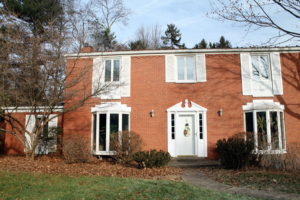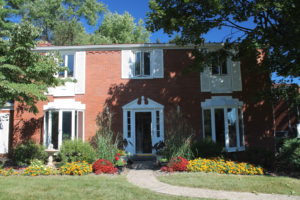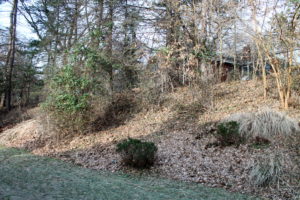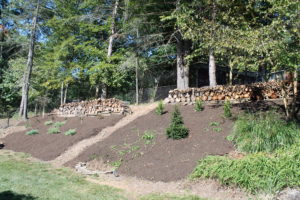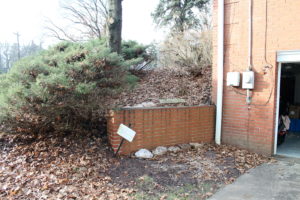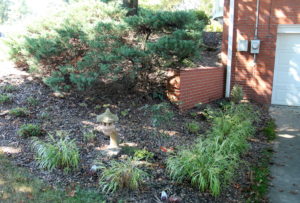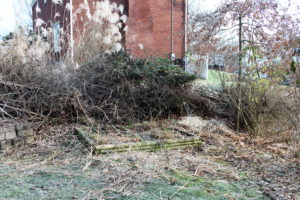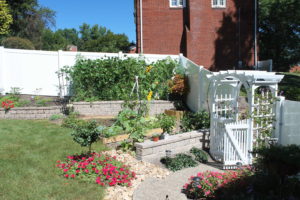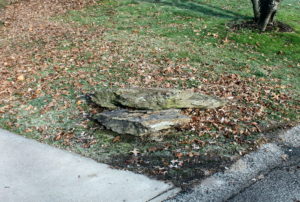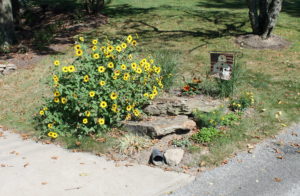From Jungle to Almost-Landscape
November 5th, 2019
In the last eight months, I’ve moved two dump truck loads of topsoil, 16 cubic yards of mulch, eight cubic yards of leaf compost, and at least 100 wheelbarrows of wood chips.
I’ve lugged 400 wall stones and two tons of drainage stone up and down steps in five-gallon buckets, laid 100 feet of drainage pipe, and built 25 feet of retaining walls three blocks high.
I’ve had four bouts of poison ivy, seven stitches after smashing my finger trying to sledgehammer a stake into rocky ground, a month-long swollen knee from overuse-related bursitis, and a constantly sore back from yanking 40-foot vines out of trees and assorted entrenched weed colonies off a huge, 25-foot-deep bank.
Finally… finally, despite side challenges with deer and rain-fueled gushing waterfalls… the Pittsburgh property that my wife, Sue, and I moved into last winter has turned the corner from jungle to almost-landscape.
I’ve progressed from hacking down and clearing out into actually planting some things. The look is now passable, which is a big improvement over atrocious.
I now no longer feel like George of the Jungle.
I knew the place needed work, but I wasn’t figuring on chain-gang levels of labor.
The main problem was that the previous owners had no interest in outdoor work. Neighbors said they seldom went outside in the last eight years, much less planted flowers or weeded.
I heard that the borough even cited them for not cutting waist-high grass in the front yard.
This was a big change of pace for me.
I’d spent the last 35 years gardening on a level, third-of-an-acre yard in Hampden Twp.
I improved that yard little by little over the years. Despite plants and garden beds everywhere, I had the work down to aging-friendly puttering.
Everything grew in that compost-enriched soil.
Read more on why I miss my old soil
Weeds had no chance to seed and spread in decades.
It got to the point where I scarcely needed a trowel to plant.
In Pittsburgh, I’ve been gardening through the clay and rock with a mattock, sledgehammer, and ibuprofen.
I tried to tackle the new “landscape” by working in phases, starting with the highest priority areas.
The front foundation went fairly well since it a.) was one of the few level areas, and b.) was mostly bare instead of jungled.
I dug out a few ugly and half-dead yews, cleared out the weeds, trimmed and fertilized four long-neglected azaleas, and planted mostly annuals this first year. A coat of mulch had it looking reasonably good.
Since deer roam with abandon, I stuck with flowers they usually don’t eat. The zinnias went untouched, the coleus got nibbled a little, the red geraniums got “deflowered” twice, and the begonias (of all things) failed altogether.
Out back, the first thing I did was install a combination of deer fence and six-foot-tall privacy fence to have any shot of gardening with deer around. So far, it’s worked. No deer damage or sightings inside the fence at all.
The big job there was clearing a bank that spans more than 100 feet and goes up at a 45-degree angle for 25 to 35 feet. I’ve been up and down it literally hundreds of times, pulling weeds, cutting brush, digging out wintercreeper vines, and pulling wild grapes, poison ivy, and wintercreeper out of the trees.
Some of the trees were dead or dying, in part from being denied sun by the weedy vines.
I’ve spent $7,000 on tree removals and cut down several smaller ones myself. I used the bigger logs to make a pair of retaining walls along the top of the bank and had most of the rest chipped, which I used as mulch throughout the yard.
Wood chips don’t rob soil of nitrogen and harm plants, as some fear. They make a decent (and free) mulch that eventually adds organic matter to the soil as it breaks down. Any loss of nitrogen during early decomposition occurs at the soil surface and not in the root zone.
I used my own chipper-shredder to grind the yanked vines and woody brush from the big bank. That was a long, hard job that just about killed the chipper-shredder (not to mention my back).
I lugged each bag of shreddings up the hill to mulch a path that spans the entire bank and creates a walking path between the deer fence at the property line and the log wall. I added a bench up there (not that I’ve used it much).
Besides openings at each end, I left one clear path down the bank – mainly for our grandkids to sled down in winter.
Once the bank was cleared, I dug planting holes with my mattock and shovel and improved each hole with a homemade mix of leaf compost from the borough, bags of mushroom manure from the garden center, and peat moss.
I’m turning the left end of the bank into a wooded area, using a triangle of small native flowering trees (a ‘Cherokee Chief’ pink dogwood, a serviceberry, and an ‘Appalachian Red’ redbud).
A line of blue hollies will screen that section of the log wall in time, and a planting of ‘Grey Owl’ junipers and ‘Double Play Pink’ spireas will cover the lower part of the bank where it’s most sunny.
Over in the middle section of the bank, I planted a triangle of ‘Green Giant’ arborvitae to screen the log wall there (and the neighbor’s house higher up). Then I planted an Oriental spruce with its sleek habit, dark-green needles, and colorful cones as the centerpiece.
Rather than try to landscape the rest of that part of the bank, I’m going to erect some sort of ornamental fencing or trellising about 28 feet across the bottom of it. That’ll screen off the lower half of the bank and be much more interesting when I get done planting the fence/trellis with clematis and front it with a band of perennials.
You won’t even be able to see what’s behind the trellis on the bank, which means I’ll be able to save work by just weed-whacking that every now and then.
The right side of the bank is where I get gushing waterfalls every time it rains heavily. I’m going to have to address that (probably with a swale and rocks to harness the flow) before I can plant.
For now, I tried covering this part of the bank with pumpkins, gourds, watermelon, and sunflowers, which haven’t done very well in the poor soil and multiple washouts.
I had much more success in the vegetable-garden area.
I started with dead plants, floppy ornamental grasses, and weeds on a 14-foot-long section of bank, plus a weedy slope of a half-hearted lawn that was constantly wet and overgrown with seeded-in rose-of-sharons.
I solved that mess by first clearing out the weeds and dead plants, then building a pair of paver-block retaining walls to carve out a nook. Then I built raised beds to get the eventual plant roots out of the sogginess and finished it off by mulching with wood chips from the cut-down trees.
Despite soil that’s about half native clay and half leaf compost, the tomatoes, peppers, beans, cucumbers, and lettuce have done reasonably well. Things should go better as I add more organic matter and fine-tune the texture and nutrition.
Another really hard area was a pair of terraces leading down to the driveway and another 60 feet of bank along the border of the driveway.
Someone had tried installing stone walls in this area years ago, but the stones had either fallen from washouts or been pushed down and covered by weeds and big, floppy miscanthus grasses.
As I dug through the mess, I unearthed 100 or so large stones that I was able to relocate into a series of curving walls that I built to slow and channel rainwater coming down from the yard above. I found more big stones on the bank in the back yard.
This was the most back-testing job of all – carrying these 20- to 40-pound stones around and setting them, one by one.
Once the stone walls were in place, I had the two dump-truck loads of topsoil delivered. Since everything was on a hill, I had to use five-gallon buckets to move almost all of it into place behind the walls.
With that done, I could then plant.
Since this area is outside the fencing, everything is up for grabs by the deer. Also, one section of it is shaded by a pair of tall oaks (root competition), and the rest gets about half a day of sun (mostly in the morning).
So what has a shot of working in that situation?
I went with three ‘Green Giant’ arborvitae (a type of western arborvitae that deer usually don’t eat as they do our native eastern arborvitae), four- to five-plant clusters of Virginia sweetspires, ‘Hummingbird’ dwarf summersweets, and ‘Mt. Airy’ fothergilla (all native shrubs), and a hedge of four Korean spice viburnums (one of the most fragrant shrubs around).
All have done well and gone untouched by the deer. So far.
In the sunniest terraces, I planted a weigela, a pair of dwarf Hinoki cypresses flanking the arbor into the back yard, a pair of dwarf lilacs, three Little Quick Fire dwarf panicle hydrangeas, an edging of black mondo grass, a colony of liriope, three ‘Silver Heart’ brunnera, a couple of mums, an upright ‘Dee Runk’ boxwood, and three Summer Crush big-leaf hydrangeas. I also transplanted five astilbes I found underneath the weedy mess.
Almost all of that has done surprisingly well this first year. Deer nibbled the hydrangeas a bit, but they’ve stayed true to the deer-resistant plant lists and avoided most everything else.
I know deer are around because they did eat some coralbells and variegated Solomon’s seal that I planted as well as mowing down hostas (one of the few “real” plants left from the previous “landscape”).
My final little job was creating a rock garden around several large stacked boulders near the driveway entrance. Previously, it was landscaped with half-dead grass and rocky dirt.
I dug out a surrounding bed, improved it with the aforementioned soil mix, and planted it with dwarf sunflowers, rudbeckias, coreopsis, creeping sedum, and three red switchgrasses that I brought from my Hampden Twp. yard.
Everything did well there, and the sunflowers in particular bloomed their heads off in a welcoming bush of gold all summer.
It’s taken a gargantuan amount of energy and tenacity (plus a visit to the Forbes Hospital ER) to get this far, but I think I’ve reached the top of the mountain and can start heading downhill from here on out.
I just hope I don’t fall and take any stone walls with me on the way down.








